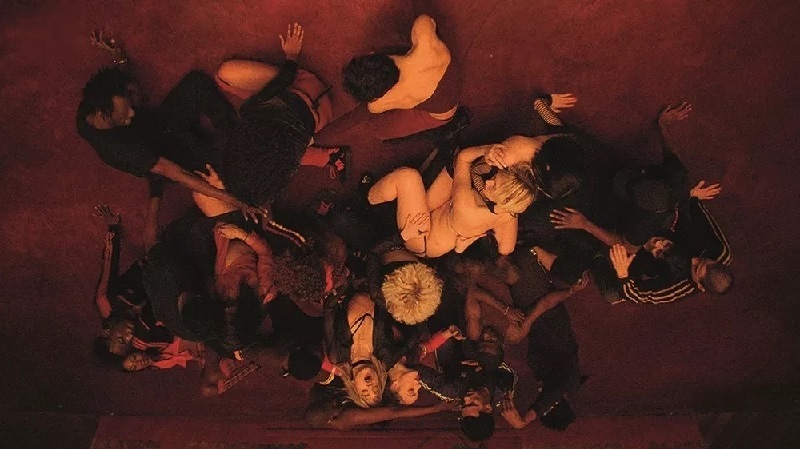If the projector burned out at the beginning of the screening and all that was left was the audio, Climax would still be a terrifying movie. The relentless beat of the music set against the constant screaming and angry voices. I’m getting ahead of myself, but that’s okay, because so does Climax.
Director Gaspar Noe opens with a woman in the throes of madness pushing herself through the snow, then stopping to make a snow angel, the blood dripping off of her arms leaving trails in the pure whiteness. Then the credits roll. Good thing I went to a matinee. If that seems like a pretentious, overly artsy move, it does have a structural purpose, as do the disruptions in the following fifteen minutes or so to add a few more credits with loud music and colorful graphics. Anything representing any kind of organization or order is disposed of in the first act. And even that is used as a device to disorient the viewer.
The audience already knows something is going to go terribly wrong – why else would they be in the theater? So when they are presented with a series of dancers’ audition interviews on a TV surrounded by books (more clues – titles include Suspiria, Possession, studies in homosexual cinema, and a book or two by Kafka), they know they are being set up. Some of the dancers are desperate to make it. Some are pure exhibitionists. But they are all ambitious and happy for the chance to be included in this project, the details of which the film never fully explains, other than the idea that France supports its native arts and that the troupe will eventually go to America.
The next scene is a choreographed rehearsal in what seems like a rec hall in an abandoned school. It’s a group number, and everyone displays a bit of their personality through different styles, twisting and contorting, posing, seducing each other. For the next hour, the music barely stops. The rehearsal turns into a party, everyone drinking sangria and breaking off into small groups in what feel like ridiculously static shots.
It feels like a student film, the camera planted and stable, focusing on groups of two or three people, a bunch of Basil Expositions reciting what turn out to be the only real plot the film has to offer. An overly-protective brother chides his younger sister about her relationship with one of the dancers. One of the organizers, with her young son in tow, reveals her dancing career had been ruined when she got pregnant. A woman is bored with her girlfriend. A virgin plots a change in status. Several of the hornier male dancers scope out their possibilities.
In the most vibrant sequence in the film, everybody goes back to dancing, but this time it’s all solos with the crowd gathered around. It’s shot from a bird’s eye view, which emphasizes and distorts the frenetic movement of the dancers, and their relationship to the crowd, which cheers each dancer on, contracting and expanding around them in a pantomime of what’s to come. End of act one.
The madness starts. The sangria has been spiked with hallucinogenics, possibly LSD. The dancers lose their inhibitions and, in one case, bladder control. An angry mob wants to know who’s responsible for the punch, and they turn on each other on a dime. Suddenly, the camera can’t stand still. It shakes and spins, sometimes gracefully following a dancer down a hallway, sometimes jerking back and forth between the mob and its defenseless target.
The next hour of Climax is pure chaos. How does one direct something like this? The camera wanders through the carnage to the pumping beat of club music. A man is exiled into the snow under suspicion of spiking the punch. A pregnant woman cuts herself to try to satiate the mob’s need to see blood. A woman is set on fire in a fight over drugs. Some of the dancers do what they’ve trained their bodies to do all their lives and never stop moving, writhing and contorting, oblivious to the violence around them. All structure is gone, and all that’s left is to endure, for characters and audience alike.
If there is a third act, it is just daybreak, when everyone’s bodies have been exhausted, some for good, and the carnage can be tallied. The lights come up in the film, and the lights come up in the theater. The credits have already rolled, and the only interruption to the nightmare has been a few puzzling title cards touting meaningless phrases like “Life is a collective impossibility” and “Death is an extraordinary experience.” There has been no real moral, just the idea that you don’t have to scratch too deep to find the worst in people. Climax takes you on a horrific ride and then dumps you back into the harsh white light, so you can tell yourself, as one character says, “Nothing happened.”

One thought on “The Horrifying Chaos of Climax”